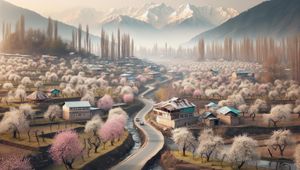You've probably heard plenty about the harmful effects of pollution, from dirty air to unhealthy drinking water, but what if pollution is also influencing the weather? A remarkable new study unveils an unexpected twist: industrial pollution may actually trigger more snowfall around factories. This intriguing phenomenon, referred to as "cloud glaciation," has sparked interest and concern as scientists investigate its underlying mechanics and potential consequences.
With winter looming, many folks are bracing for cold temperatures and snow. But for some living close to heavy industrial activity, the prospect of snowfall may come with added surprises. Researchers from the University of Tartu and the University of Reading have delved deep, showing how emissions from factories can lead to changes not just in air quality, but also precipitation patterns.
Cloud glaciation occurs when minute particles from pollution serve as nuclei, allowing water droplets to freeze and form ice crystals, which eventually lead to snow. This process typically kicks off between -10°C and -24°C (14°F to -11°F), temperatures often reached during colder months. Interestingly, the study indicates this transformation is largely driven by man-made pollutants spewing from sources like coal power plants and metal factories.
To reveal these findings, scientists analyzed satellite data, observing cloud formations near 67 industrial sites across North America, Europe, and Asia. What they discovered was telling: liquid clouds near factories were morphing disproportionately to ice clouds, even under conditions where such changes wouldn’t usually happen. Surprisingly, this led to more significant snowfall, with researchers noting accumulations averaging 1.2 mm (about 0.05 inches) per hour and exceeding 15 mm (over half an inch) over wider areas.
This isn't just about aesthetics; the consequences for communities are significant. Areas downwind of factories may need to prepare for abrupt snowfalls, leading to public safety concerns and potentially hazardous conditions. Professor Nicolas Bellouin, one of the study's co-authors, emphasized, "While we already knew about the health impacts of air pollution, we now know it can alter weather patterns, causing unexpected snowfall where it might not normally occur."
This newly highlighted link between pollution and weather shifts begs the question: what does this mean for the bigger picture? Typically, clouds help reflect sunlight back to space, playing a major role in regulating Earth's temperature. Pollution-induced ice clouds reflect less sunlight than their liquid counterparts, possibly leading to warming effects for the planet.
The relationship between industrial pollution and weather patterns highlights the interconnectedness of environmental factors. More research is needed, as scientists strive to understand how these particles from pollution interact with clouds and influence precipitation over time. The study, published in the top-tier journal Science, suggests these findings could have broader implications than previously considered.
Considering the serious health risks associated with high levels of pollution—especially prevalent during winter months when fog and smog combine with industrial emissions—these insights are increasingly relevant. Delhi, India, has made headlines for its dire air quality during colder months, illustrating the grave consequences such pollution can have on both human health and local ecosystems.
While residents might welcome the sight of snow, especially during the holidays, it’s clear they might need to think twice before heading outside. The amount of snowfall resulting from industrial emissions could disrupt everyday life, leading to questions about infrastructure and emergency preparedness for unexpected weather events.
The researchers behind this study advocate for greater awareness of how air pollution can lead to rare climatic changes, urging communities near industrial sites to be ready for heavy snowfalls. Traditional views of weather patterns don’t always account for the influence of human activity, underscoring the necessity for public policies aimed at reducing emissions and fostering sustainability.
All things considered, this latest research serves as both enlightening and alarming. While snowy winters might seem like good news for some, the role of industrial pollution brings to light new challenges related to environmental health. Sunset skies over industrial sites may come with unexpected snow—an eerie reminder of the impact we have on our surroundings. With the winter months on the way, vigilance and preparedness will be key for those affected.



